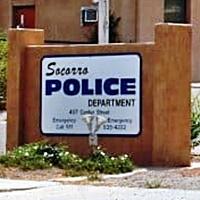
The Trinity Site brings thousands of visitors to White Sands when it is open for visitors twice a year. The first open-to-visitors-day this year will be Saturday, April 1.
File photo | El Defensor Chieftain
The nuclear age was born on former Socorro County ranch land some 34 miles southeast of San Antonio on July 16, 1945. This Saturday, April 1, the Trinity Site can be visited firsthand during the semiannual open house from 8 a.m. to 2 p.m.
Visitors to the site’s April and October open houses have steadily grown over the past dozen years. A turnout of over 5,000 participants is not unusual. Although no record is kept of where attendees come from, license plates in the sprawling parking lot account for dozens of states.
The simplest way to get to Trinity Site is to enter White Sands Missile Range through its Stallion Range Center gate. The turnoff is 12 miles east of San Antonio at the historical marker, and the Stallion gate is five miles south.
The Stallion Gate is open from 8 a.m. to 2 p.m. Visitors arriving between those hours will be allowed to drive the 17 miles to Trinity Site unescorted. The road is paved and marked.
Alternate access to the open house is from Alamogordo via a caravan that leaves from the Tularosa High School athletic field parking lot. Due to the annual visitor increase, the Alamogordo caravan is only open to the first 125 vehicles. The limit is necessary to maintain a safe environment en route to Trinity Site. Once at the site, vehicles must leave through the Stallion Gate. There is no caravan back to the Tularosa High School football field parking lot.
The 51,500-acre area was declared a national historic landmark in 1975. The landmark includes ground zero where the bomb exploded; the base camp where scientists and support staff were housed; the remains of one of the tower columns; and the Schmidt/McDonald ranch house south of the site where the core of the bomb was assembled.
In addition, one of the old instrumentation bunkers is still visible beside the road just west of ground zero.
Although radiation levels are low, some feel any extra exposure should be avoided. The decision is yours.
It should be noted that small children and pregnant women are potentially more at risk than the rest of the population. They are generally considered groups who should only receive exposure in conjunction with medical diagnosis and treatment.
Typical radiation exposures for Americans per the American Nuclear Society:
- One hour at Trinity Site ground zero – one half mrem
- Cosmic rays from space – 47 mrem at Denver per year, 28 mrem at St. Louis
- Radioactive minerals in rocks and soil – 63 mrems per year on Colorado Plateau
- Radioactivity from air, water and food – about 240 mrem per year
- About six mrem per chest X-ray, 65 mrem per hip X-ray, and 110 mrem for a CAT Scan
- Watching television – less than one mrem per year
- Wearing a plutonium-powered pacemaker – 100 mrem per year
The site closes promptly at 3:30 p.m. Visitors must have a Real ID card, U.S. passport, or military ID to enter.

















